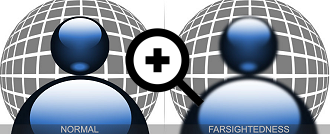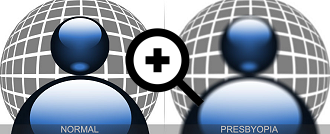Monday - Friday, 8am to 5pm
Not sure if you have an eye problem? Need to know if there is a procedure to correct your eye problem? Click on the links below to find out about common problems with vision and the eye.
Symptoms of Nearsightedness
Most people that are nearsighted have difficulty reading highway signs and seeing other objects at a distance, but can see for up-close tasks such as reading or sewing.
It can be an inherited trait that often becomes evident in children at about eight to twelve years of age. Typically, the condition increases as the body grows during teenage years before it stabilizes in adulthood.

Causes
Nearsightedness occurs when the eyeball is slightly longer than usual from front to back. This causes light rays to focus at a point in front of the retina, rather than directly on its surface.
Treatment Available
Nearsightedness can be corrected with: refractive surgery such as iLASIK, PRK, RLE, Implantable Collamer Lenses, or Verisyse Phakic Intraocular Lens.
Symptoms of Farsightedness
People with farsightedness can see distant objects very well, but have difficulty seeing objects that are up close. Farsighted people sometimes have headaches or eyestrain, and may squint or feel fatigued when performing work at close range.

Causes
Farsightedness occurs when light rays entering the eye focus behind the retina, rather than directly on it. The eyeball of a farsighted person is shorter than normal.
Treatment Available
Farsightedness can be corrected with: glasses or contact lenses, refractive surgery such as iLASIK or RLE.
Symptoms of Astigmatism
Slight or significant blurred vision at any distance, headaches or eyestrain. Can accompany nearsightedness and farsightedness.

Causes
Astigmatism occurs when the cornea is shaped more like an oblong football than a spherical baseball, which is the normal shape. The oblong shape causes light rays to focus on two points in the back of your eye, rather than on just one.
It can rarely be caused by lid swellings such as chalazion, corneal scars, or by keratoconus.
Treatment Available
Astigmatism can be corrected with: glasses or contact lenses, refractive surgery such as iLASIK, PRK or LRI.
Symptoms of Presbyopia
Presbyopia is caused by an age-related process. As you become older, you may have difficulty in focusing your eyes for close objects, such as when reading, sewing, or working at the computer.
You may find you need to hold books, magazines, newspapers, menus and other reading materials at arm's length in order to focus properly. It may also produce headaches, eyestrain, or fatigue.

Causes
Presbyopia is caused when the lens of the eye loses some of its flexibility and cannot focus sharply on near objects. Presbyopia is an inevitable companion of middle age. No treatment, including diet and exercise, can inhibit its progress.
Treatment Available
Presbyopia can be corrected with: glasses with bifocal or progressive addition lenses (PALs) or bifocal or multifocal contact lenses. Refractive surgery such as iLASIK or RLE with a Multifocal Lens Implant.
Symptoms of Cataracts
Clouding of the eye's natural lens, sensitivity to excessive light, difficulty reading, loss of color perception, loss of depth perception, night blindness, and suddenly being able to read without your glasses.

Causes
Cataracts occur when the protein in the lens, which is usually arranged in a precise way that keeps the lens clear and allows light through, starts clumping together to cloud a small area of the lens. This is the start or beginning of a cataract, and over time, it may grow larger and cloud more of the lens, making it harder to see.
Treatment Available
Cataracts can be corrected with: intraocular Lens, glasses or contacts.
Glaucoma is a term used to describe a group of diseases in which the pressure within the eye is increased, resulting in damage to the optic nerve. Glaucoma is a potentially blinding disease. It can be controlled with medication, but it cannot be cured.
Glaucoma is caused when the pressure in the eye (intraocular pressure, or IOP) increases to dangerous levels, damaging the optic nerve. This can result in decreased peripheral vision and eventually blindness.
Glaucoma has NO warning symptoms in its early stages. Early detection and treatment are key, as the prognosis can be good with medical or surgical treatment.

Glaucoma Treatment
Glaucoma can be treated in a number of ways, including:
Medication - Medicine in the form of eyedrops is tried first to control the pressure in the eye.
Laser Surgery - There are several lasers that can be used based on the type of glaucoma being treated.
Conventional Surgery - If medications and laser treatment fail to bring glaucoma under control, glaucoma surgery may be indicated.
Symptoms of Macular Degeneration
The typical first symptom of AMD is blurring of vision. Blurred and distorted central vision, blind spots and loss of color vision. Although peripheral vision remains intact, victims lose the ability to read, to drive, and to see fine detail. Straight lines, such as the edges of doorways, may start to look bent or crooked as vision becomes distorted.

What Causes AMD?
Scientists have not yet learned why a healthy macula begins to degenerate. Heredity likely plays a role, as does ethnicity - AMD is more common in Caucasians. It is also possible that tissue changes which accompany the normal aging process somehow interfere with the macula getting enough oxygen. Smokers and former smokers have been found to have a much higher risk of AMD. Other risk factors are high blood pressure and high cholesterol. The condition does not appear to be caused by diabetes or by drinking alcoholic beverages.
Drusen
As the normal eye ages, tiny yellowish deposits called "drusen" sometimes build up under the macula. The "hard" form of drusen may be a normal and harmless sign of getting older, but "soft" drusen can be a sign that degenerative macular changes are starting to develop. Yet AMD sometimes develops without any visible drusen at all.
Types of AMD
There are two major forms of AMD, called "dry" and "wet." Most patients have the dry form, which tends to develop slowly as the tissue (pigment epithelium and visual cells) beneath the macula gradually deteriorates. With wet AMD, tissue deterioration is accompanied by tiny abnormal blood vessels called choroidal neovascular membranes. These form under the retina and start to leak fluid or bleed. If the fluid or blood reaches the macula and lifts it out of position, vision becomes distorted and visual sharpness can be lost.
Symptoms
The typical first symptom is blurring of vision. As time goes on, you may notice a hazy or dark zone in the center of objects you look at directly. Colors may begin to look different or lose richness. With wet AMD especially, straight lines, such as the edges of doorways, may start to look bent or crooked as vision becomes distorted and wavy. Symptoms may be gradual or sudden. When the loss of vision is in one eye only, you can't always tell how long it has existed, since it is "hidden" when both eyes are used together. It may only become apparent when the good eye is covered. Some people whose vision has been very poor (from AMD or from other causes) sometimes have visual hallucinations; they see things (objects or patterns) that are not really there. These phantom visions can last from a few seconds to a minute or so and then disappear. Such hallucinations are fairly common and they are not serious, but they can be startling.
Treatment
Currently there are three main medications used to treat wet AMD. These medications can decrease bleeding and swelling caused by the abnormal blood vessels.
All patients with AMD should cease smoking if they are smokers. Vitamin supplementation with a special formula (AREDS2 formula) helps to reduce your risk of progression to advanced AMD in patients with moderate and advanced AMD.
Dry Eye
Symptoms of Dry Eye include stinging, burning, scratchy sensation, sensitivity to light, tearing, tired eyes, contact lens discomfort and blurred vision. Often dry eye symptoms are mistaken for allergies, climatic conditions or just "eyestrain."
Causes
Environmental: Hot, dry and/or windy climates, high altitudes, excessive sun exposure, central heating, air conditioning, cigarette smoke, air pollution, air travel.
Refractive eye surgeries: Dry eye is the most common complaint following LASIK. Your doctor should test your eyes prior to surgery to ensure the best outcome.
Contact lens wear: Two million people a year give up on wearing contact lenses, and 50% of these people cite dryness or discomfort as their number one complaint. If you have Dry Eye Disease, your doctor may be able to prescribe a specific lens for your condition or prescribe treatment to allow you to wear your lenses more comfortably.
Low blink rate: Blinking is critical in stimulating tear production, as well as spreading the tears across the eye's surface. The three common culprits responsible for reducing your blink rate are computer use, reading, and watching TV. Sometimes just remembering to blink can improve how your eyes feel.
Medications: It is important that your eye doctor know all of the medications that you take. Some medications known to aggravate Dry Eye Disease include allergy medications, decongestants, antidepressants, blood pressure medications, birth control pills, diuretics, and pain medications.
Diseases: Some diseases associated with dry eye disease incluce diabetes, Parkinson's disease, Sjogren's syndrome, Rheumatoid arthritis, Lupus, Lacrimal Gland Deficiency, Blepharitis, Stevens-Johnson syndrome, and Rosacea.
Hormonal deficiencies or changes: Thyroid conditions, hormonal changes during menopause, decreased production of androgen, and estrogen supplementation can all affect ocular health. Be sure to let your doctor know if you are taking hormone replacement therapy or have a thyroid condition.
Treatment Available